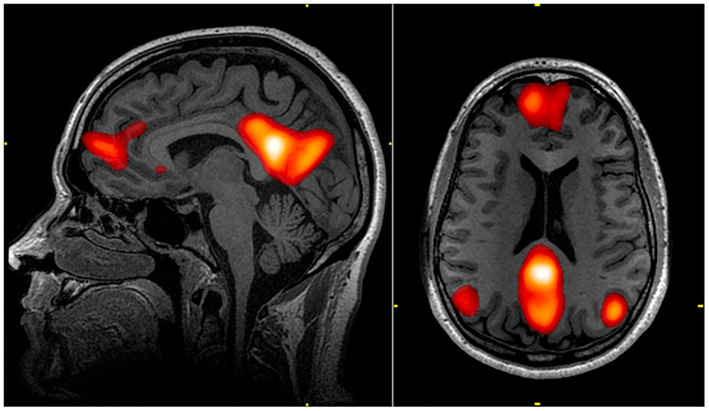Default mode network🧠

The default mode network is a brain network primarily composed of the dorsal medial prefrontal cortex and the posterior cingulate cortex, and also involves the precuneus and angular gyrus. The network forms a critical and centrally located hub of brain activity that links parts of the cerebral cortex to the limbic system.
Working at a remove from our sensory processing of the outside experienced world, the default mode network is most active when we are engaged in higher-level “metacognitive” processes such as activities that involve self-reference, thinking about others, remembering the past, planning for the future, mental constructs, moral reasoning, and theory of mind. It is also linked to clinging to or trying to control ones experience. These thoughts and activities share the common feature of me: I’m remembering, I’m deciding, i want, etc. Thus, it is sometimes referred to as the “me” network—linking ourselves to our inner and outer worlds. This is why decreased activity in the default mode network is correlated with a decreased sense of self. All these functions may belong exclusively to humans, and specifically to adult humans, for the default mode network isn’t operational until late in a child’s development.
One of the most important—and sometimes pernicious—constructs created by the default mode network is what we call the self, or ego. If a researcher gives you a list of adjectives and asks you to consider how they apply to you, it is your default mode network that leaps into action. Nodes in the default network are also thought to be responsible for autobiographical memory, the material from which we compose the story of who we are, by linking our past experiences with what happens to us and with projections of our future goals. Self-reflection can lead to great intellectual and artistic achievement but also to destructive forms of self-regard and many types of unhappiness.
The default mode network is best known for being active when a person is not focused on the outside world and the brain is at wakeful rest, such as when we’re daydreaming and mindwandering. Lapses in attention have been linked to increased activity in these brain regions. When our attention lapses, we fall into a daydream, or we start thinking about something we may need to do later, and then these brain regions light up. The default mode network stands in a kind of seesaw relationship with the task-positive network which wakes up whenever the outside world demands our attention; when one is active, the other goes quiet, and vice versa.
Because the brain developed a hierarchical structure through evolution by building off of its preexisting capabilities, the default mode network exerts a top-down inhibitory influence on the older brain structures, many of which communicate with one another through its centrally located hub. Neuroscientist Dr. Robin Carhart-Harris has described the DMN variously as the brain’s “orchestra conductor,” “corporate executive,” or “capital city,” charged with managing and “holding the whole system together.” And with keeping the limbic system in check, in much the same way Freud conceived of the ego keeping the anarchic forces of the unconscious id in check. Dr. David Nutt puts the matter bluntly, claiming that in the DMN “we’ve found the neural correlate for repression.”
The brain contains several different specialized systems—one for visual processing, for example, another to control motor activity—each doing its own thing. Interference between different systems is averted because all systems are not created equal. Electrical signaling from some brain areas takes precedence over others. At the top of this hierarchy resides the DMN, which acts as an uber-conductor to ensure that the cacophony of competing signals from one system do not interfere with those from another. I imagine this to be mostly the case for the left default mode network since the right hemisphere has a more loose orginazational structure than the left hemisphere.
The default mode network doesn’t only exert top-down control over material arising from within; it also helps regulate what is let into consciousness from the world outside, operating as a kind of filter. Then, with the help of the default mode network, our left hemisphere unconsciously focuses on only a select few of the sensory signals it receives that it considers important.
References
-
Brewer, Judson. (2017). The Craving Mind Why We Get Hooked and How We Can Break Bad Habits Chapter 6. Addicted to Thinking (Location 1585). New Haven, CT: Yale University Press.
-
Pollan, Micheal. (2018). How to Change Your Mind Chapter 5. The Neuroscience of Your Brain on Psychedelics (Location 4122). New York, NY: Penguin Random House.
-
Pollan, Micheal. (2018). How to Change Your Mind Chapter 5. The Neuroscience of Your Brain on Psychedelics (Location 4176). New York, NY: Penguin Random House.
-
Pollan, Micheal. (2018). How to Change Your Mind Chapter 5. The Neuroscience of Your Brain on Psychedelics (Location 4188). New York, NY: Penguin Random House.
-
Hanson, Rick. (2009). Buddha’s Brain The Practical Neuroscience of Happiness, Love, and Wisdom Chapter 2.The Evolution of Suffering (p. 44). New Harbinger Publications: Oakland, CA.
Metadata
Type:🔵 Tags: Biology / Neuroscience / Anatomy / Neuroanatomy Status:☀️